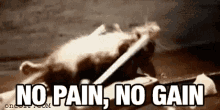How Hard Should You Exercise?
“Go heavy or go home bro”.
“No pain no gain.”
I don’t know about you, but this doesn’t make exercise sound massively enticing.
No wonder people feel reticent about going to the gym.
Who wants to go where the whole ethos is to make you hurt?
Now before anyone starts spitting out their protein shake in anger let’s get something clear.
Yes, the gym is a place to become stronger, healthier and where you can build an inner strength that radiates into other areas of your life.
Yes, to do this you have to challenge yourself, give your body a little more to do than it’s used to.
It needs a stimulus to become stronger.
And yes, I think most people are not aware of how much they can do, how hard they’re able to work and because of this may not achieve the results they’re capable of.
But, the devil is in the dosage.
Most coaches, “fitness influencers” and athletes have taken these jobs because they have a background in fitness.
They have a solid foundation to their strength and endurance.
They learn from other pro’s who train people at an elite level.
Already fit people, whose job it is to be fit and therefore have more time/inclination to focus on their recovery.
However, the people I see are rarely like this…especially when we first meet.
They have careers and families.
They probably haven’t seriously exercised in years.
They’re baffled as to what they should be eating.
They’re short on time, stressed and often knackered.
If they train like someone who lives to post workouts on Instagram they could screw themselves up long term.
Why?
How hard we train needs to be governed by our ability to recover.
Training is a stress on the body.
Just like an unexpected tax bill, missing sleep when your child is sick, working long hours with little downtime or filling your body with junk food.
But training should be a planned and controlled stress.
In the short term you’ll have a decrease in performance.
Imagine if Usain Bolt had been for a big workout before the Olympic final.
He wouldn’t have destroyed the field in the way he did because he would be fatigued from the previous work.
It’s not just physical performance that will see a decrease.
Most systems in the body, such as the immune system will be repressed.
This should just be a short-term dip in form.
If recovery goes well, you will recover to above your current baseline.
Overtime you’ll become stronger, fitter and healthier.
But without adequate recovery, all you do is dig a deeper and deeper hole.
So yes, you do have to challenge yourself…
…but…
…the level of challenge has to fit with your current life situation, training level and nutritional skills.
What works for a kid free, 20 something, fitness pro who lives for the gym, won’t be what’s best for a dad of three who is holding down a busy career, spends hours at a desk and is venturing back to exercise for the first time in years.
How do you know how hard to go?
There are certain markers you can pay attention to.
Soreness is a good starting point.
A bit of soreness is to be expected and even feels kind of nice.
You know you’ve done something.
But if the soreness is so much that you feel too screwed to train and start missing workouts, then it’s counterproductive.
Heart rate is a great marker.
It pays to check your morning heart rate when you’re in a rested state (not the day after a workout).
You can then check it regularly in the morning (either feel your pulse or there are free apps you can download).
If you notice an elevation over a couple of beats then the chances are you haven’t yet recovered.
Getting more techie, HRV is a great marker.
This is a measure of the variability between your heart beats.
Larger variations are a sign of being well recovered, lower numbers indicate that your body may need a bit more TLC.
There are apps that provide HRV readings but to be accurate you’d be wise to invest in something such as an Oura ring or a Whoop band.
Neither of these are cheap, so don’t feel they’re essential. Only go for these if you have the funds and you really like digging into data.
Your body is great at telling you how it’s doing, we just need to pay it some attention.
Your mood is a great example.
If you’re bouncing out of bed and loving life, then chances are you’re recovering great and you’re ready to give those weights what for.
On the other hand, a drop in mood, having less patience with those around you usually indicates it may be time to make some changes.
A final interesting test is your grip strength.
Grip is controlled by the nervous system.
If you’re fatigued, then your grip strength will decrease.
Suddenly finding the dumbells heavy or struggling to hold a weight that has previously been comfortable is another clue to make a change.
What should you do?
You have three main options.
1. Decrease the amount of effort you’re expending.
This could be decreasing the volume of your workout, how often you train or the type of exercise you do (e.g switching yoga for a weight session)
2. What recovery activities can you add to your lifestyle?
Before you start shouting that you’re too busy already, I mainly thinking of the big rocks.
Are you drinking enough water? Eating enough protein? Having a sleep routine that winds you down? Getting some veggies into your life? Decreasing/avoiding alcohol?
You know…the things you kinda know you should be doing but you’re hoping to off set by going to the gym.
3. A mixture of one and two.
My initial instinct is to go for number three.
Add in recovery activities, monitor how you respond and then increase the training effort whilst maintaining those recovery strategies.
Training is great.
Getting after it, pushing yourself and making gains is fun and a great life lesson.
But the goal is to make yourself feel better.
Monitor how you’re responding and react to that data.
Don’t think you’re being weak for dialing back.
And never underestimate the importance of enough sleep, water and protein.


